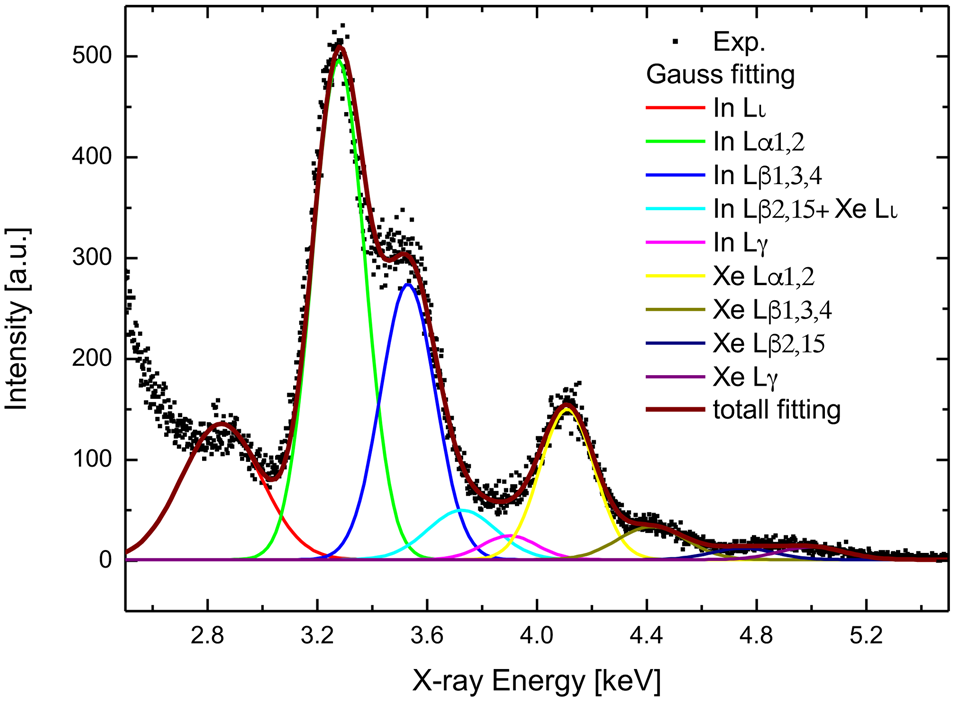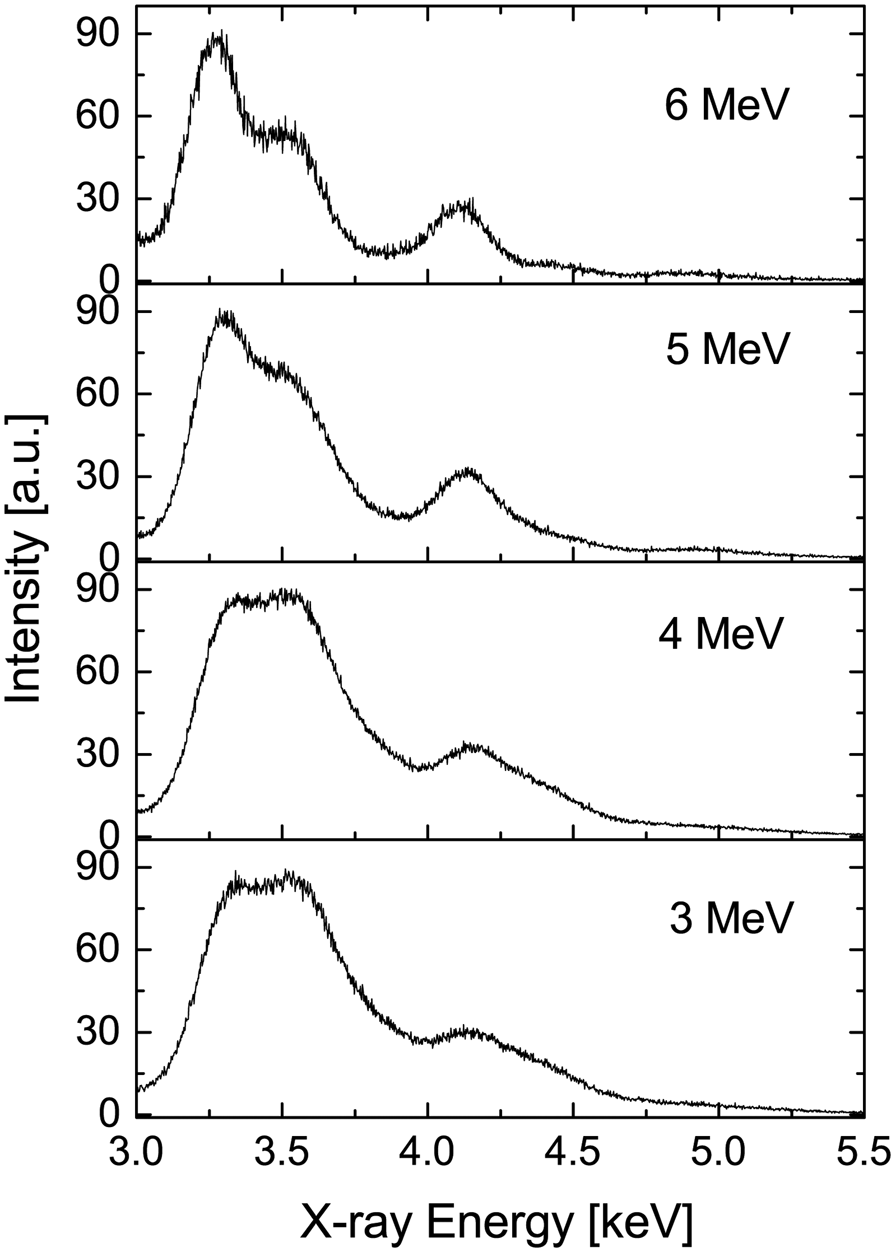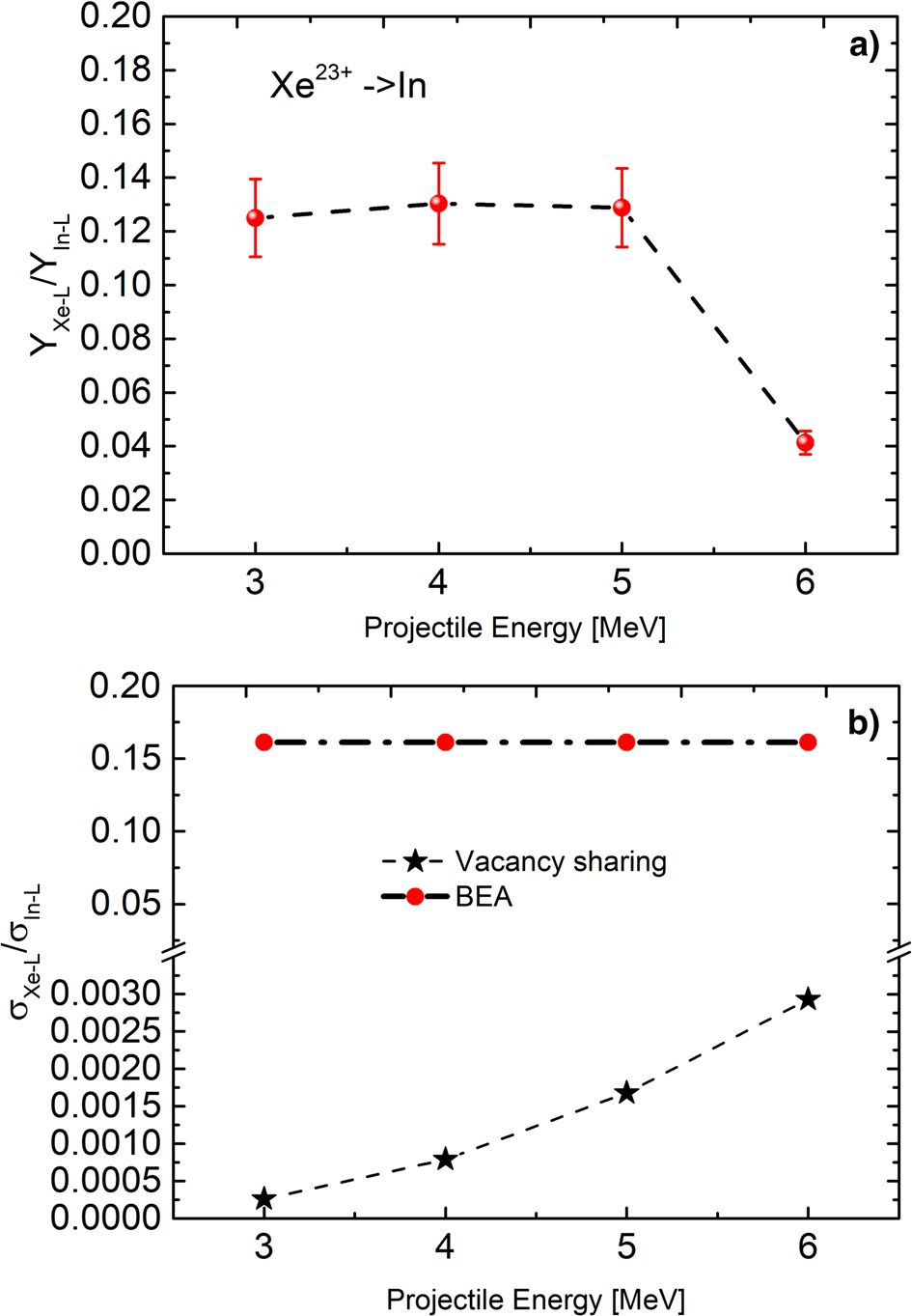The study of X-ray emissions induced from highly charged ion-atom collisions attracts continuous attentions (Kavanagh et al., Reference Kavanagh, Cunningham, Der, Fortner, Khan, Zaharis and Garcia1970; Datz et al., Reference Datz, Moak, Appleton and Carlson1971; Lutz et al., Reference Lutz, Stein, Datz and Moak1972; Anholt et al., Reference Anholt, Meyerhof, Stoller, Morenzoni, Andriamonje, Molitoris, Baker, Hoffmann, Bowman, Xu, Xu, Frankel, Murphy, Crowe and Rasmussen1984; Schonfeldt et al., Reference Schönfeldt, Mokler, Hoffmann and Warczak1985, Reference Schönfeldt, Mokler, Hoffmann and Warczak1986; Watson et al., Reference Watson, Blackadar and Horvat1999, Reference Watson, Peng, Horvat and Perumal2006, Reference Watson, Horvat and Peng2008; Horvat et al., Reference Horvat, Watson and Peng2009; Ren et al., Reference Ren, Zhao, Zhou, Wang, Lei, Xu, Cheng, Wang, Liu, Sun and Xiao2015), since it is one of the most efficient ways to probe the inner-shell ionization/excitation mechanisms and helps to provide basic data for various fields such as atomic physics (Mokler and Folkmann, Reference Mokler and Folkmann1978), plasma physics (Bitter et al., Reference Bitter, Hsuan, Bush, Cohen, Cummings, Grek, Hill, Schivell, Zarnstorff, Beiersdorfer, Osterheld, Smith and Fraenkel1993; Hill et al., Reference Hill, Scott, Bell, Budny, Bush, Clark, Denne-Hinnov, Ernst, Hammett, Mikkelsen, Mueller, Ongena, Park, Ramsey, Synakowski, Taylor and Zarnstorff1999; Chen et al., Reference Chen, Beiersdorfer, Fournier and Träbert2002), and astrophysics. It has been found that for collisions either in a high energy region (v p ≫ v e, where v p and v e are velocities of projectile and involved target orbit electrons, respectively) or Z p ≪ Z t (where Z p and Z t are atomic number of projectile and target, respectively), the Coulomb ionization dominates the vacancy production process (Garcia et al., Reference Garcia, Fortner and Kavanagh1973; McGuire and Richard, Reference McGuire and Richard1973). In the past decades, numerous theoretical formula has been formed to calculate the ionization cross section, such as classical binary-encounter approximation (BEA) (Gryzinski, Reference Gryzinski1965), plane-wave Born approximation (PWBA) (Johnson et al., Reference Johnson, Basbas and McDaniel1979), and ECPSSR (Brandt and Lapicki, Reference Brandt and Lapicki1981), which complements the influence of projectile energy loss, Coulomb deflection, target ionization within the perturbed stationary state, and relativistic corrections to electrons. In an intermediate energy region (v p ~ v e), molecular effects become important (Barat and Lichten, Reference Barat and Lichten1972; Eichler et al., Reference Eichler, Wille, Fastrup and Taulbjerg1976). Namely, when the collision partners approach each other, they do form quasi-molecular orbits, from which the electrons are ionized/excited through direct ionization or rotational coupling. On the outgoing way, the vacancies are shared between the collision partners through radial coupling. The occurrence of molecular effects actually require appropriate incident energies that, on the one hand, are high enough to allow the collision partners approaching each other and, on the other hand, low enough to ensure the interaction timescale for the molecular orbit formation. The dominant role of molecular effects in incident energy range of 0.1–10 MeV/u has been reported in a series of papers (Meyerhof et al., Reference Meyerhof, Anholt, Saylor, Lazarus, Little and Chase1976, Reference Meyerhof, Anholt and Saylor1977, Reference Meyerhof, Rüetschi, Stoller, Stockli and Wölfli1979; Anholt and Meyerhof, Reference Anholt and Meyerhof1977). However, for collisions with lower incident energies, experimental data are limited.
The inner-shell processes involving L-shell are more complicated than K-shell cases and are currently far to be fully understood. Previous studies show that for highly charged ion-atom collisions in the intermediate energy region, the total L X-ray emission intensity of projectile present obvious peak structures versus target atomic number, which can be qualitatively explained by molecular effects near the level-matching region (Kavanagh et al., Reference Kavanagh, Cunningham, Der, Fortner, Khan, Zaharis and Garcia1970; Kubo et al., Reference Kubo, Jundt and Purser1973; Woods et al., Reference Woods, Hopkins, Kauffman Robert, Elliott, Jamison and Richard1973; Meyerhof et al., Reference Meyerhof, Anholt and Saylor1977; Ren et al., Reference Ren, Zhao, Zhou, Cheng, Lei, Sun, Wang, Xu, Wang, Liu, Yu, Li, Zhang, Xu and Xiao2013). However, the L α/L β intensity ratio variation is still not fully interpreted (Datz et al., Reference Datz, Moak, Appleton and Carlson1971; Meyerhof et al., Reference Meyerhof, Anholt and Saylor1977; Genz et al., Reference Genz, Hoffmann, Löw and Richter1979; Saha Amal et al., Reference Saha Amal, Dhal, Thulasi Ram, Padhi, Kurup, Prasad and Tandon1998a, Reference Saha Amal, Dhal, Tiwari, Kurup, Padhi, Prasad and Tandon1998b), especially its dependence on the incident energy. Meyerhof et al. (Reference Meyerhof, Anholt and Saylor1977) systematically investigated the L α/L β intensity ratio as a function of incident energy and target atomic number in collisions of highly charged ions with various solid targets. In the framework of radial coupling between molecular orbits, the variation in the L α/L β intensity ratio is explained by the molecular orbital correlation shift from the BL (Barat and Lichten) to Eichler rule as the asymmetry of the collision system increases. Saha Amal et al. (Reference Saha Amal, Dhal, Thulasi Ram, Padhi, Kurup, Prasad and Tandon1998a, Reference Saha Amal, Dhal, Tiwari, Kurup, Padhi, Prasad and Tandon1998b) measured the L X-ray emissions in collision of tens of MeV highly charged ions with thin solid target later. Combining the data from Datz et al. (Reference Datz, Moak, Appleton and Carlson1971), the L α/L β intensity ratio of iodine ions over a large incident energy range of 6–180 MeV are studied. It is found that as the asymmetry of the collision system increases, the molecular orbital correlation rule shift theories cannot even qualitatively reproduce the experimental results at low impact energies.
To extend the experimental data availability and investigate the inner-shell ionization/excitation mechanism, we measured the X-ray emissions in interaction of highly charged Xe ions with the solid target in energy range of several MeV. Here, we report about the L X-ray emissions induced in Xe + In collision systems. The relative intensity of target-to-projectile L X rays and the target L α/L β intensity ratio as a function of projectile energy are investigated. The results are examined in terms of direct ionization and molecular orbital couplings, whose relative roles are discussed.
The experiment was performed at the 320 kV high-voltage platform at the Institute of Modern Physics (IMP) in Lanzhou. Highly charged ions were generated from electron cyclotron resonance (ECR) ion source and directed by two quadrupole lenses to the target chamber after momentum analysis in a 90° bending magnet. The pressure in the target chamber was kept below 10−10 mbar. The highly charged ions impact perpendicularly onto the target. The X rays were detected at 45° with respect to the incident beam line by a silicon drifted detector, which has a resolution of 136 eV full-width at half-maximum at X-ray energy of 5.9 keV. The number of incident ions on the target was monitored temperally with a calibrated transmitting Faraday cup. More experimental details can be found in Zhou et al. (Reference Zhou, Cheng, Zhao, Wang, Lei, Chen, Ma and Xiao2019).
The typical X-ray spectra induced by 6 MeV Xe23+ impacting on In target is shown in Figure 1. Xe Lι X rays overlap with In Lβ2,15 lines and the relative intensities are extracted according to the well-resolved lines. It was reported that in highly charged ion-atom collisions, the Lι/Lα intensity ratio shows no big difference over a large range of target atomic number and changes only slightly with the incident energy. Therefore, here we use the reported data concerning 15–60 MeV iodine ions interacting with various solid target, in which Lι/Lα is about 0.07, to extract the Xe Lι X-ray intensity. Consequently, the intensity of In Lβ2,15 can be obtained as well.

Fig. 1. Typical spectra induced by Xe23+ impacting on In target.
The X-ray spectra induced by 3–6 MeV Xe23+ impacting on In target is shown in Figure 2. The structures of the spectra exhibit strong dependence on the projectile energy. The projectile-to-target L X-ray yield ratio is shown in Figure 3a as a function of incident energy. The uncertainty of about 5% mainly comes from the intensity determination from the area of Gauss fitting profiles. It can be seen that in the incident energy range of 3–5 MeV, the projectile-to-target L X-ray yield ratios keep nearly constant and are significantly reduced when the incident energy is increased from 5 to 6 MeV.

Fig. 2. X-ray spectra induced by 3, 4, 5, and 6 MeV Xe23+ impacting on In target.

Fig. 3. (a) Projectile-to-target L X-ray yield ratio in collision of Xe23+ with In target. (b) The theoretical predictions of the projectile-to-target L-vacancy production cross-section ratios based on the vacancy sharing model as well as the BEA.
The projectile-to-target L-vacancy production cross sections are calculated by the well-known BEA function developed by Gryzinski (Reference Gryzinski1965) as well as the vacancy sharing model formulated by Meyerhof et al. (Reference Meyerhof, Anholt and Saylor1977). In the vacancy sharing model, the In L 1 electrons are promoted through 4fσ molecular orbit (MO), and on the outgoing part of the collision, the vacancies are shared by the nearby levels such as In L 2, In L 3, Xe L 1, Xe L 2, and Xe L 3. If we do not differentiate the subshells, the overall projectile-to-target L-vacancy production cross-section ratio σXe-L/σIn-L can be simplified as ωL/(1 − ωL):
 $${\rm \omega}_L/\lpar 1-{\rm \omega}_L\rpar = \exp\lpar -2{\rm \lambda}_L\rpar \comma \quad 2{\rm \lambda}_L={\pi\vert \sqrt{I_{{\rm Xe}}}-\sqrt{I_{{\rm In}}} \vert\over \sqrt{{1 \over 2}mv_{\rm p}^2}},$$
$${\rm \omega}_L/\lpar 1-{\rm \omega}_L\rpar = \exp\lpar -2{\rm \lambda}_L\rpar \comma \quad 2{\rm \lambda}_L={\pi\vert \sqrt{I_{{\rm Xe}}}-\sqrt{I_{{\rm In}}} \vert\over \sqrt{{1 \over 2}mv_{\rm p}^2}},$$where ωL and 1 − ωL are the total vacancy sharing ratio of Xe L- and In L-shell from 4fσ orbit, respectively, I Xe and I In are the binding energy of Xe and In L-shell, respectively, m is the electron mass, and v p is the projectile velocity.
As shown in Figure 3b, the vacancy sharing model predictions of Xe L/In L-vacancy production cross-section ratios are the orders of magnitude lower than the BEA result, and the predicted increasing trend disagrees with the measurement. Therefore, we conclude that the vacancy sharing contribution of 4fσ MO to Xe L-shell can be neglected. The BEA formula, which describes the Coulomb ionization process, predicts a constant projectile-to-target L-vacancy production cross-section ratio. This corresponds to the constant X-ray emission intensity ratio neglecting the variation of the fluorescence yield in the incident energy region. Therefore, the observed nearly constant projectile-to-target L X-ray intensity ratio for incident energy smaller than 5 MeV can be qualitatively explained by the Coulomb ionization process.
As for the observed ratio reduction for incident energy larger than 5 MeV, we attribute it to the activation of rotational coupling of 4fσ orbit. Unlike vacancy sharing, which happens at the large and wide range of internuclear distance, rotational coupling mostly occurs at much smaller internuclear distances; therefore, sufficient incident energy is needed to trigger this process. Since 4fσ MO correlates to the In L 1 shell, the triggering of this process greatly increases the In L-shell vacancy production cross section. Consequently, the reduced Xe/In L X-ray intensity ratio is expected. The experimental data indicated that the threshold of 4fσ MO rotational coupling process in the Xe and In collision system is about 5 MeV.
The Lα/Lβ1,3,4 intensity ratio of In target is observed to increase obviously with the incident energy, as shown in Figure 4. Since Coulomb ionization theory predicts a constant ratio, the results indicate the importance of the relationship between the subshells. As discussed above, the vacancies generated through 4fσ MO, which correlates to the In L 1 shell, are shared by In L 2 and In L 3 shells, when reasonably neglecting the sharing process of Xe L shells. Namely, the vacancy production cross sections of In subshells could be described as below:
 $${\rm \sigma}_{L3}={\rm \omega \sigma}_{4f\,{\rm \sigma}}\comma \quad {\rm \sigma}_{L_1+L_2} =\lpar 1-{\rm \omega}\rpar {\rm \sigma}_{4f\,{\rm \sigma}},$$
$${\rm \sigma}_{L3}={\rm \omega \sigma}_{4f\,{\rm \sigma}}\comma \quad {\rm \sigma}_{L_1+L_2} =\lpar 1-{\rm \omega}\rpar {\rm \sigma}_{4f\,{\rm \sigma}},$$where  ${\rm \sigma }_{L_3}$ is the vacancy production cross section of the In L 3 shell,
${\rm \sigma }_{L_3}$ is the vacancy production cross section of the In L 3 shell,  ${\rm \sigma }_{L_1+L_2}$ is the sum of vacancy production cross sections of In L 1 and In L 2 shells, and ω is the vacancy sharing probability from 4fσ MO to In L 3 shell. The vacancy production cross-section ratio of the In L 3 shell to In L 1 + L 2 shells can be simplified as ω/(1 − ω), which is formulated to increase with the incident energy. In view of the fact that the Lα lines emit from the electron transition to L 3 vacancies, and Lβ1,3,4 lines from the electron transition to In L 1 and In L 2 vacancies, increasing Lα/Lβ1,3,4 intensity ratios are expected consequently. The experimental results can be qualitatively explained by the vacancy sharing model. On the other hand, the agreement validates Meyerhof's proposal that the molecular orbital correlation relationship tend to obey Eichler rule for asymmetric collision.
${\rm \sigma }_{L_1+L_2}$ is the sum of vacancy production cross sections of In L 1 and In L 2 shells, and ω is the vacancy sharing probability from 4fσ MO to In L 3 shell. The vacancy production cross-section ratio of the In L 3 shell to In L 1 + L 2 shells can be simplified as ω/(1 − ω), which is formulated to increase with the incident energy. In view of the fact that the Lα lines emit from the electron transition to L 3 vacancies, and Lβ1,3,4 lines from the electron transition to In L 1 and In L 2 vacancies, increasing Lα/Lβ1,3,4 intensity ratios are expected consequently. The experimental results can be qualitatively explained by the vacancy sharing model. On the other hand, the agreement validates Meyerhof's proposal that the molecular orbital correlation relationship tend to obey Eichler rule for asymmetric collision.

Fig. 4. In Lα/Lβ1,3,4 intensity ratio as a function of projectile energy in collision of Xe23+ with In target.
In summary, the X-ray emission induced in interaction of Xe23+ with solid In target is measured. It is found that the projectile-to-target L X-ray intensity ratio keeps nearly constant in the incident energy region of 2–5 MeV, which could be well explained by Coulomb ionization theory. When the incident energy is larger than 5 MeV, the projectile-to-target L X-ray intensity ratio is greatly reduced due to the activation of rotational coupling process of 4fσ MO, which correlates to the In L-shell. The incident energy-dependence Lα/Lβ1,3,4 intensity ratio shows the importance of vacancy sharing between L subshells and validated Meyerhof's proposal that the 4fσ MO tends to correlates to L 1 subshell for asymmetric collisions.
Acknowledgments
We sincerely thank the staff from 320 kV high-voltage platform at the Institute of Modern Physics (IMP) for providing the highly charged ion beams. The work is supported by the National Natural Science Foundation of China (Grant Nos 11705141 and 11775282), the National Key Research and Development Project No. 2019YFA0404900, and the Postdoctoral Research Foundation of China (Grant No. 2017M623145).





